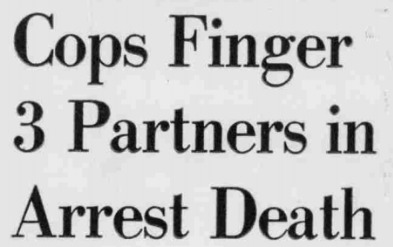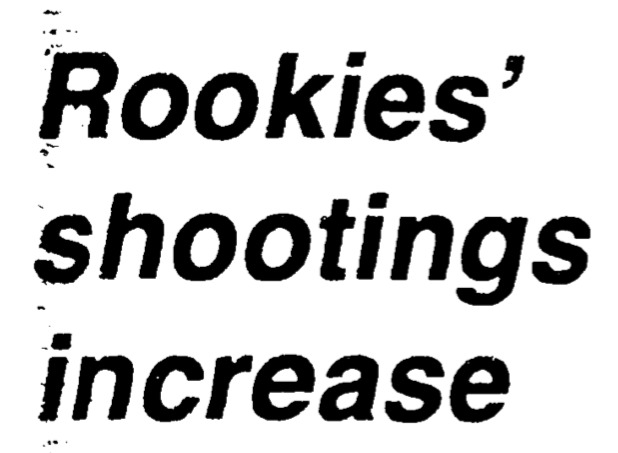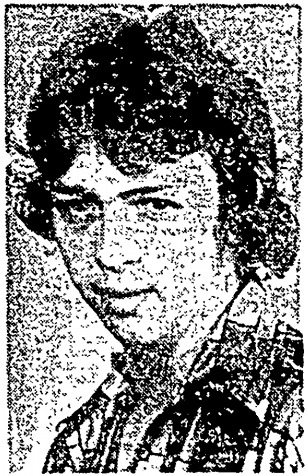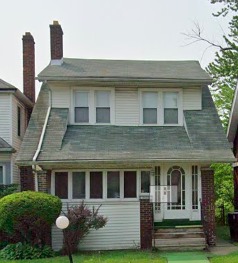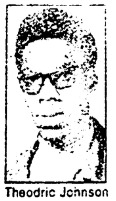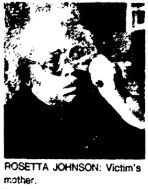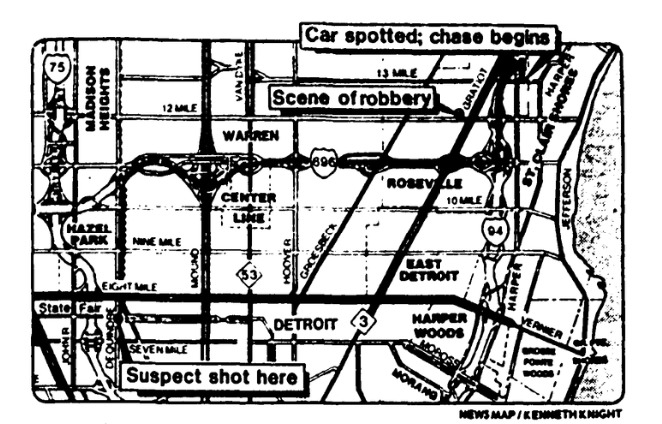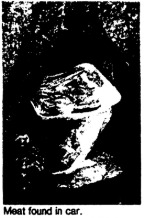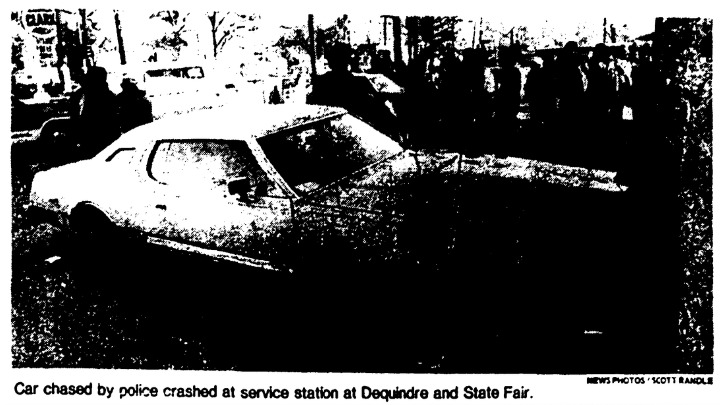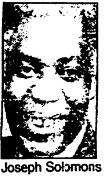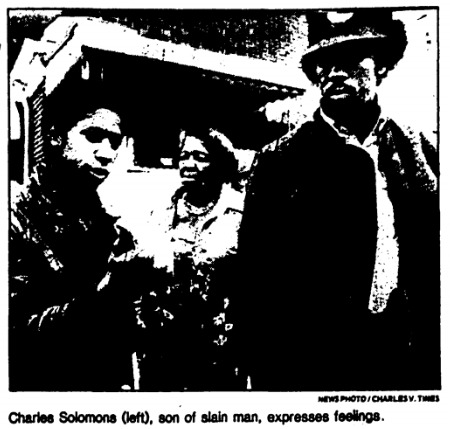Police Homicides
Police Homicides Compared to Racial Demographics (1978-1981)
Police Homicides Compared to Income Level (1978-1981)
Patterns In Police Homcides (1978-1981)
Leslie Wayne Armstrong was killed by three Detroit Police officers as they arrested him at around 11:15 pm on May 19th, 1978. Officers Charles Springer and Sherry Butler had found Armstrong parked in front of a fire hydrant. After discovering that Armstrong had warrants for previous traffic violations they threatened him with arrest. In response, Armstrong ran from the officers but was soon caught with help from a third officer named Jay Hammer. Armstrong was handcuffed and Hammer pinned Armstrong down with his knee on the back of his neck. By that point two more police officers had arrived at the scene in response to radio calls for help put out by Springer and Butler. According to the court testimony of these officers, Hammer and Springer assaulted the handcuffed Armstrong with a flashlight, beating him and dragging him 10 feet with the flashlight positioned under his neck. Armstrong died later that night while still in police custody. A medical examiner determined that Armstrong’s cause of death was strangulation. One of the officers present later testified that they saw Officers Hammer and Springer meet just after the incident to “get their stories together”.
Rufus Lewis, a fifteen year old student at Murray Junior High School in Detroit, was killed by an off-duty Detroit police officer, Sgt. Robert F. Dougherty, just after 3:00 a.m. on June 19th, 1978. That night Dougherty received a call informing him that someone had broken a window of the house across from his. The house belonged to another officer who had asked Dougherty to watch the property while he was away on vacation. When Dougherty arrived on the scene Lewis was trying to get out of the house through a broken kitchen window while his friend and accomplice was already climbing the back fence in an attempt to escape. When the two teens allegedly failed to respond to Dougherty’s order to stop he shot Lewis through the kitchen window. Lewis’ body was found on the floor of the kitchen suggesting he had hardly moved between when Dougherty first saw him and the moment he shot and killed him.
Gerald Snowden, a 23 year old Detroiter was shot and killed by rookie Detroit Police Officer Chris Henry just after 7 a.m. on June 11th, 1978. The shooting took place after Officer Henry and his partner, another rookie officer named Gary Williams, pulled Snowden over for running a stop sign. The two rookie officers failed to follow police procedure and waited for Snowden to get out of his vehicle and approach them at the window of their patrol car instead of approaching him at his window. When Snowden could not provide a valid driver's license, the officers told him that they would have to take him to jail, at which point Snowden began running from them on foot. As Henry chased Snowden he pulled out his gun. Henry shot Snowden, killing him, after Snowden allegedly lunged at him from the opposite side of a fence he had just climbed. According to Officer Henry the shot was accidental. An account of the killing in the Detroit News emphasized the fact that both Henry and his partner were rookies with less than a years experience on the force and that Henry had been rushed through a condensed version of the police training course as a part of Coleman Young’s efforts to add new officers to the department in the late 1970’s.
Glover Cook, a 32 year old Detroit man, died in police custody when he was left unconscious in the back of a scout car for an hour after being arrested on July 9, 1978 at around 7:30 pm. Cook was “forcibly subdued” by police after he allegedly assaulted his wife and threw a neighbor child into a basement freezer. The arresting officers, Alvin Samuel and Gloria Gaines, didn’t leave for the hospital for almost 30 minutes despite the pleas of Mrs.Cook and other neighbors to do so. Upon arrival at the hospital, the officers told hospital workers that Cook was a “psycho,” but did not mention his other injuries. The officers then left Cook in the backseat for 20 minutes while they allegedly tried to find a stretcher to transport Cook into the hospital, however, hospital officials later stated that there were stretchers available. The Wayne County Medical Examiner determined Cook’s death to be due to a heart attack “aggravated by Cook’s loss of blood and physical exertion.” While the Free Press did not report exactly how Cook sustained the injuries that led to a loss of blood, we might suspect that officers severely wounded Cook while “forcibly subdu[ing]” him. Cook’s wife filed a lawsuit suing the city of Detroit for negligence in her husband’s death. According to the widow’s attorney, the officers could have taken Cook to five nearby hospitals that would have been closer than Detroit General Hospital, which was 11 miles away. Officers claimed that they were just following standard procedure.
Patsy Dalton, 30 was shot and killed by Officer Jack Carr in her home on July 13, 1978 around 3 am after Carr came to her house answering a “family trouble call.” Police say that when they arrived at the home they were told that Dalton had 2 knives and had threatened the family. Police say that when they went to the bedroom to talk to Dalton, she ran toward him armed with 2 knives and Carr fired twice, killing her. The family denies the officer’s account of the incident, saying that Dalton only had one knife and was trying to close the bedroom door when Carr fired the first shot, and Dalton dropped the knife before Carr fired the second shot.
Sherman Justice, 30, was killed by off-duty Officer Richard Knox on August 6, 1978. Knox was reportedly at his home when relatives alerted him that there was a neighborhood fight over a basketball game. Upon arriving at the scene, Knox claims he saw Justice fire a handgun at a group of young people he was arguing with. Police say Justice then fired 3 shots at Knox after Knox ordered Justice to drop the gun. Knox fired 2 shorts, hitting Justice in the head and chest. No other bystanders were injured by shots fired by Justice or Knox.
Thomas Ward, 33, was shot and killed by off-duty officer Edgar Hale after an alleged argument between the two on the street on August 13, 1981 at about 8:30 pm. Hale was held overnight in police custody for questioning. [*Possible concluding sentence about how this incident ties into broader trends of off-duty cops seemingly using their power as officers to settle personal disputes].
Oscar Lee Benson, a 43 year old man from the eastside of Detroit, was shot and killed by two Detroit Police officers at 7:40 pm, on March 22nd, 1978. Benson had allegedly been arguing with a group of people and was armed with a hammer and a knife. Officers Walter Kushard and Michael Kenley of the Tactical Services Section of the Detroit Police Department were driving past the supermarket when they saw a parked patrol car and decided to offer assistance to the officers already on the scene. According to police Benson stabbed a passerby repeatedly. After being ordered to drop his weapon Benson turned and slashed his knife at Officer Cushard cutting his hand. Benson was then shot multiple times in his face, neck, and chest. Benson died about an hour later in Detroit General Hospital.
Mark Thomas was a fifteen year old boy living with his family in Detroit’s west side near Dearborn when he was shot and killed by police. On February 28th, 1979, several officers investigating a breaking and entering in the neighborhood showed up with tracking dogs at Thomas’ family’s house and ordered Thomas along with three of his siblings to line up in the front yard. The officers singled out Thomas’ thirteen year old brother Brian and took him back to the station. Brian was released the following day, but Thomas was angered with what he viewed as police harassment of his family and his younger brother. According to one of Thomas’ other brothers, he had been struggling with depression based on a feeling that he was useless to his family. Thomas was apparently also very protective of his younger brother Brian. He had spent nine months in a boys center the year prior after getting in trouble for fighting with kids in his neighborhood who had threatened to beat up Brian. The night after the police took his brother into custody, Thomas borrowed a rifle from one of his friends and set out, alegedly to get revenge on the police. According to Thomas’ mother, the gun had a broken firing pin and couldn’t shoot. Unfortunately, the police who encountered Thomas later that night didn’t know that his weapon wasn’t functional. After Thomas raised the rifle in their direction, the police shot him in the side; he died later that night at Mt. Carmel Hospital.
Michael Langdon, 24, was shot and killed by Detroit Police Officer John Leavens on March 20, 1979. Langdon had been involved in a bank robbery and Detroit police along with several FBI agents had tracked him down to a hotel room in Highland Park. Langdon cooperated with police after their arrival, following their orders to turn away from them and to place his hands against the wall of the hotel room. At that point Officer John Levens shot Langdon in the back with his shotgun. According to Levens, Langdon backed into the barrel of his gun, inadvertently causing Levens to pull the trigger. Langdon’s father sued the city of Detroit on behalf of his son’s estate following his son's death.
J. C. Ealey Jr., a 34 year old man from Detroit, was shot and killed by Detroit Police Commander Philip Aerrola and his partner Patrick Fitzgerald, just after 7 a.m. on December 11th, 1979. Ealey had broken into the enclosed front porch of a house on the northwest side of Detroit. Armed with a rifle, Ealey had alerted the residents of his presence by screaming “They’re after me! Somebody's after me!”. When Aerrola and Fitzgerald entered the porch area, Ealey allegedly pointed his rifle at them. Ealey was hit in the chest and died shortly after. It seems quite likely that Ealey was suffering from some type of mental illness due to the fact that he seemed to delusionally believe he was being chased. According to a relative, Ealey was unemployed and suffered from alcoholism.
Theodric Johnson, an unarmed 30 year old man, husband, and father of a five year old girl, was shot and killed by two plainclothes St. Clair Shores police officers on March 16th, 1981. On that day, Johnson made the fatal mistake of stealing a few frozen steaks from a grocery market. After taking the stakes, Johnson got into a car with two other men and drove off. The incident was reported to police and just a few minutes later the vehicle was spotted and an unmarked St. Clair Shores police car took pursuit. The car carrying Johnson and the two other men led police on a high speed chase through six Detroit suburbs. The chase ended when a tire on Johnson’s car blew out and the vehicle crashed into a gas station. Proceeding the crash, Johnson got out of the car and started running away from the plainclothes St. Clair Shores officers who ordered him to stop. Those same officers then shot at Johnson, hitting him in the back of his head and killing him. The two other men who had been in the car surrendered themselves to police. No weapons were found on Johnson, the other two men, or in the vehicle. The shooting of Johnson caused a fair deal of controversy with many criticizing the police response as being too extreme based on the low level nature of the original crime. A Detroit News article about the incident was critical of the officers for engaging in the high speed pursuit in the first place, noting that many such pursuits lead to civilian casualties. Johnson’s family was also frustrated with the police response, emphasizing that Johnson was unarmed and didn’t pose a threat to the officers or anyone else.
Joseph Solomons Jr., a 50 year old cement worker, father of five and well respected community member was shot and killed by plainclothes police in the driveway of his own home on March 20th, 1981 at around 6:15 p.m. The two police officers involved in the shooting, John Shuel and Richard Nixon, were dressed in “tattered hippie clothing” and were driving an unmarked car. They had stopped one of Solomons’ sons, 22 year old Alvin Solomons, directly outside of Mr. Solomons’ house in connection with an armed robbery. As the younger Solomons procured his ID for the officers, they mistook a pellet gun in his waistband for a genuine weapon. Responding to the sight of the weapon the officers shoved Alvin Solomons down onto the hood of their car to arrest him. At that moment, Mr. Solomons was inside his house getting ready to go out to get groceries for his wife. Looking out the window of his house, Mr. Solomons saw his son being pushed around and restrained by two men dressed in street clothes. Believing the officers to be criminals themselves, attacking his son, Mr. Solomons rushed outside with a handgun to confront the men.
According to the police, upon seeing Solomon they yelled to him that they were police officers and waved their badges before Solomon fired his pistol at them. Several witnesses, however, denied that account saying that Shuel and Nixon did not identify themselves. Two of Solomons family members who were at the house at the time told the Detroit News that not only did the officers fail to identify themselves, but that Mr. Solomons didn’t even fire his weapon at all. Other neighbors also expressed doubt that Mr. Solomons would have fired or even pointed his gun at the two cops if he knew they were police officers. What is known for sure is that Shuel and Nixon fired several shots at Solomons hitting him in the chest multiple times. After Mr. Solomons fell to the ground the officers didn’t offer him any assistance and forced his family back into their house at gunpoint. An ambulance didn’t arrive for 20 minutes after the shooting, by which time Mr. Solomons had died, lying alone in his own driveway. Mr. Solomons’ death outraged many of his neighbors who described him as “churchgoing, warm, and hardworking”, “the peace-maker of the neighborhood”, and “an upstanding citizen”. Mr. Solomons’ killing is a powerful example of the flaws of undercover and plainclothes policing, especially in a high crime city such as Detroit. Without markings clearly designating Shuel and Nixon as police officers, it was far too easy for Mr. Solomon to mistake them for criminals shaking down his son. Although the STRESS era ended with the election of Coleman Young, plainclothes policing continued to present problems both for Detroiters and for police themselves.
Michael Urquhart, 25, was killed by an off-duty police Officer William Fraser on October 15, 1978 after Urquhart fled the scene on foot after allegedly fired several times at a party store owner during an attempted robbery. Fraser shot Urquhart in the chest after Urquhart allegedly fired twice at Fraser. Fraser was alerted of the situation when his son woke him up from a nap to tell him about the incident. Police say they recovered $150, several lottery tickets, and beer that Urquhart stole from the store.
Robert Mendoza, 22, was killed by police on May 27. 1981 around 6 pm after firing several shots with a shotgun on the roof of a building down the street from his parents’ home. Officers Daniel Budz, Larry Kuwalek, and Sgt. Thomas Hulkkonen fired at Mendoza and shot him once in the forehead. The bullet allegedly did not lodge in Mendoza’s skull, making it impossible to determine which officer was responsible for the lethal shot. The three officers were reportedly transferred to duty off the street, but the police investigation determined no wrongdoing by the officers. His family and friends said that he had been dealing with mental health issues and attempted suicide in the past.
Sources:
The Detroit News, NewsBank.
The Detroit Free Press, Proquest Historical Newspapers.
The Michigan Chronicle, Hatcher Graduate Library, University of Michigan.
Google Maps Images, Google.

